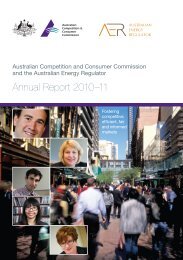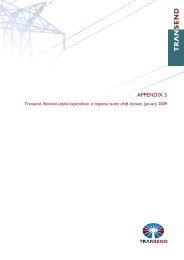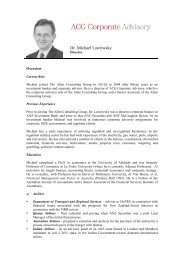Internal consistency of risk free rate and MRP in the CAPM
Internal consistency of risk free rate and MRP in the CAPM
Internal consistency of risk free rate and MRP in the CAPM
You also want an ePaper? Increase the reach of your titles
YUMPU automatically turns print PDFs into web optimized ePapers that Google loves.
5. Why required returns on <strong>risk</strong>ier assets are not fall<strong>in</strong>g <strong>in</strong><br />
l<strong>in</strong>e with CGS yields<br />
78. The previous section provided an empirical description <strong>of</strong> <strong>the</strong> fact that required returns<br />
on o<strong>the</strong>r assets have not been fall<strong>in</strong>g with <strong>the</strong> most recent fall <strong>in</strong> CGS yields – such<br />
that <strong>risk</strong> premiums (spreads) have been ris<strong>in</strong>g. Section 5.1 below section expla<strong>in</strong>s<br />
why this has been happen<strong>in</strong>g <strong>in</strong>clud<strong>in</strong>g by reference to <strong>the</strong> views <strong>of</strong> o<strong>the</strong>r experts such<br />
as <strong>the</strong> RBA. Section 5.2 <strong>of</strong> this report also canvasses <strong>the</strong> RBA’s views on <strong>the</strong> extent<br />
to which a ‘scarcity premium’ or ‘liquidity premium’ is currently depress<strong>in</strong>g <strong>the</strong> yield for<br />
CGS <strong>and</strong> <strong>the</strong> likely implications for future levels <strong>of</strong> CGS yields.<br />
5.1. Flight from <strong>risk</strong>y to safe assets<br />
79. The <strong>CAPM</strong>, or, more precisely, <strong>the</strong> Sharpe-L<strong>in</strong>tner version <strong>of</strong> <strong>the</strong> <strong>CAPM</strong>, predicts that<br />
<strong>the</strong> expected yield on any asset will be determ<strong>in</strong>ed by <strong>the</strong> follow<strong>in</strong>g formula:<br />
Competition Economists Group<br />
www.CEG-AP.COM<br />
( )<br />
80. This formula describes an <strong>in</strong>vestor’s required return on any asset – be that asset debt,<br />
equity or any o<strong>the</strong>r asset. The asset’s beta (βi) is a measure <strong>of</strong> <strong>the</strong> <strong>risk</strong> <strong>of</strong> that asset<br />
relative to <strong>the</strong> <strong>risk</strong><strong>in</strong>ess <strong>of</strong> <strong>the</strong> market portfolio. The <strong>MRP</strong> describes <strong>in</strong>vestors’ required<br />
compensation for <strong>the</strong> <strong>risk</strong> associated with hold<strong>in</strong>g <strong>the</strong> market portfolio.<br />
81. Investors’ required compensation for <strong>the</strong> <strong>risk</strong> associated with any <strong>in</strong>dividual asset can<br />
<strong>in</strong>crease for one or both <strong>of</strong> two reasons:<br />
� <strong>the</strong> asset’s beta can <strong>in</strong>crease (i.e. <strong>the</strong> asset’s <strong>risk</strong> relative to all o<strong>the</strong>r <strong>risk</strong>y assets<br />
can <strong>in</strong>crease); or<br />
� <strong>the</strong> market <strong>risk</strong> premium can <strong>in</strong>crease.<br />
82. It is AER’s practice to implement <strong>the</strong> <strong>CAPM</strong> formula above assum<strong>in</strong>g that <strong>the</strong> <strong>risk</strong> <strong>free</strong><br />
<strong>rate</strong> is best proxied by <strong>the</strong> prevail<strong>in</strong>g yield on 10 year CGS. Given this practice,<br />
<strong>in</strong>ternal <strong>consistency</strong> requires that <strong>the</strong> <strong>MRP</strong> be measured relative to <strong>the</strong> prevail<strong>in</strong>g yield<br />
on CGS.<br />
83. However, <strong>the</strong> factual analysis <strong>of</strong> <strong>the</strong> previous section demonst<strong>rate</strong>s that <strong>the</strong> dramatic<br />
fall <strong>in</strong> 10 year CGS yields <strong>in</strong> late 2011 was not associated with similarly dramatic<br />
reductions <strong>in</strong> required yields on o<strong>the</strong>r assets – be those assets relatively low <strong>risk</strong> debt<br />
or <strong>the</strong> relatively high <strong>risk</strong> listed equity market.<br />
84. The only <strong>in</strong>ternally consistent explanation for this evidence is that <strong>the</strong>re has been an<br />
across <strong>the</strong> board <strong>in</strong>crease <strong>in</strong> <strong>the</strong> <strong>risk</strong> premiums (measured relative to 10 year CGS<br />
yields) that <strong>in</strong>vestors require. This need not be because <strong>in</strong>vestors are dem<strong>and</strong><strong>in</strong>g a<br />
20







